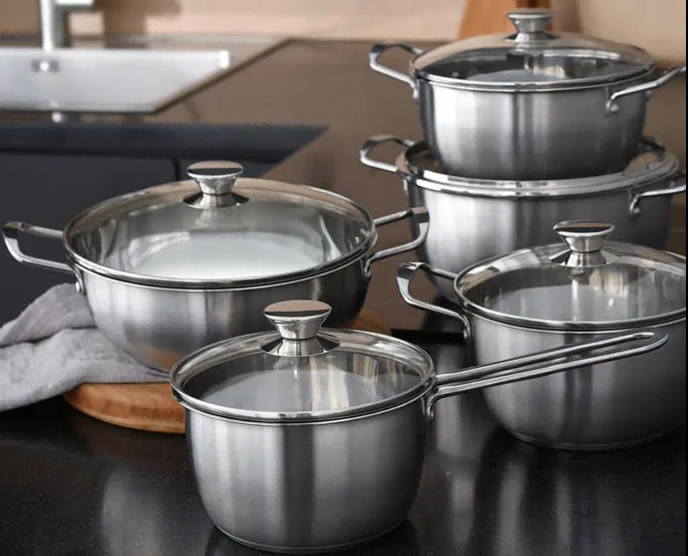Hello everyone, today I want to talk to you about two common kitchen utensils: aluminum cookware and 스테인리스 스틸 조리기구. Cooking is an indispensable part of life, and choosing the right cooking tools can greatly enhance our cooking experience. Aluminum cookware and stainless steel cookware have their own advantages and disadvantages in cooking, and different characteristics determine their different roles in the kitchen.
As a professional 도매 조리기구 제조업체, I will introduce their characteristics to you in detail, hoping that you can better choose the cookware that suits you.
Aluminum Cookware: Efficient Heat Transfer
Aluminum cookware is very popular in both commercial and home kitchens because of its excellent thermal conductivity.
Advantages of Aluminum Cookware
Thermal conductivity: Aluminum cookware can transfer heat quickly and evenly, and its thermal conductivity is several times that of most metals, making the cooking process more efficient. For employees and workers, it is particularly time-saving to use aluminum pots to cook fast food to prepare breakfast quickly!
가벼움: Aluminum cookware is very light, easy to carry and very convenient to use, suitable for outdoor cooking or daily kitchen operations.
경제적입니다: Compared with other materials, aluminum cookware is more affordable due to its abundant aluminum resources and relatively low processing costs.
Disadvantages of Aluminum Cookware
But it also has disadvantages:
Not wear-resistant: Aluminum is soft and easily scratched, affecting its appearance and service life.
Not friendly to acidic foods: Aluminum is prone to chemical reactions in an acidic environment, causing aluminum to dissolve, which will have a certain impact on human health.
Not resistant to high temperatures: Although aluminum has good thermal conductivity, its melting point is relatively low. Pure aluminum cookware is easy to deform at high temperatures and is not suitable for high-temperature barbecue or long-term high-temperature heating. Therefore, many aluminum pans are given a non-stick coating or anodized to enhance durability.

Stainless Steel Cookware: Durable And Safe
Stainless steel cookware is synonymous with “durability” in the kitchen and is also a very advanced cookware choice.
Advantages of Stainless Steel Cookware
Safety: Stainless steel cookware does not react with acidic or alkaline foods, and does not release harmful substances at high temperatures. It is a very safe choice.
손쉬운 청소: Stainless steel has a smooth surface and is not easy to absorb food residues. It can be easily cleaned with ordinary detergent and soft cloth.
Disadvantages of Aluminum Cookware
Poor thermal conductivity: Single-layer stainless steel is not as conductive as aluminum, which means it may take longer to reach the ideal cooking temperature when heated. However, there are many three-layer composite bottom stainless steel pots on the market now, which combine the thermal conductivity of aluminum with the durability of stainless steel and become the best choice for cooking!
Higher price: High-quality stainless steel cookware is usually designed with multiple layers of composite materials to improve thermal conductivity and durability. Such process and material costs make the price of stainless steel cookware generally higher than some traditional cookware, suitable for users who pursue quality.

Aluminum Vs Stainless Steel Pots
| Aspect | 알루미늄 조리기구 | 스테인리스 스틸 조리기구 |
| 열 전도성 | Excellent heat conductivity, heats up quickly and evenly, ideal for fast cooking. | Poor heat conductivity in single-layer designs, but multi-layered options improve performance. |
| 무게 | Lightweight and easy to handle, great for small kitchens or outdoor use. | Heavier, offering better stability, suitable for long-term kitchen use. |
| 내구성 | Softer material, prone to scratches and deformation. | Durable, corrosion-resistant, and scratch-proof. |
| 가격 | More affordable with high cost-effectiveness. | Higher upfront cost but longer lifespan, making it more economical in the long run. |
| Health and Safety | May react with acidic or alkaline foods, posing potential risks. | Non-reactive with food, ensuring a high level of safety. |
| 청소의 용이성 | Non-stick coating is easy to clean but may wear off over time. | Smooth surface resists sticking, making cleaning hassle-free. |
| Appearance | Available in various colors, often with anodized finishes. | Sleek metallic finish with a classic and elegant look. |
| Heat Resistance | Pure aluminum can deform at high temperatures; non-stick coatings have limited resistance. | Excellent heat resistance, maintains shape under high temperatures. |
| Best Use Scenarios | Ideal for quick cooking and budget-friendly options. | Perfect for those prioritizing quality, safety, and longevity. |
Choice Between The Two
If you focus on cost-effectiveness and often need to cook quickly, aluminum cookware would be a good choice.
If you pursue durability and health and safety, stainless steel cookware would be more suitable. In particular, the composite bottom design takes into account both fast heating and even cooking.
요약
Aluminum cookware and stainless steel cookware have their own characteristics. The most important thing is to choose the right cookware according to your actual needs.
If the budget is sufficient, you can consider mixing and matching, such as aluminum frying pan + stainless steel soup pot. You can also combine the advantages of both and choose a stainless steel wok with a three-layer composite aluminum bottom, which can not only enjoy the fast and uniform heat conduction of aluminum, but also take into account the durability and safety of stainless steel.
I hope that through the sharing of this article, everyone can have a deeper understanding of the characteristics of aluminum and stainless steel cookware, and help you choose the most suitable cookware
